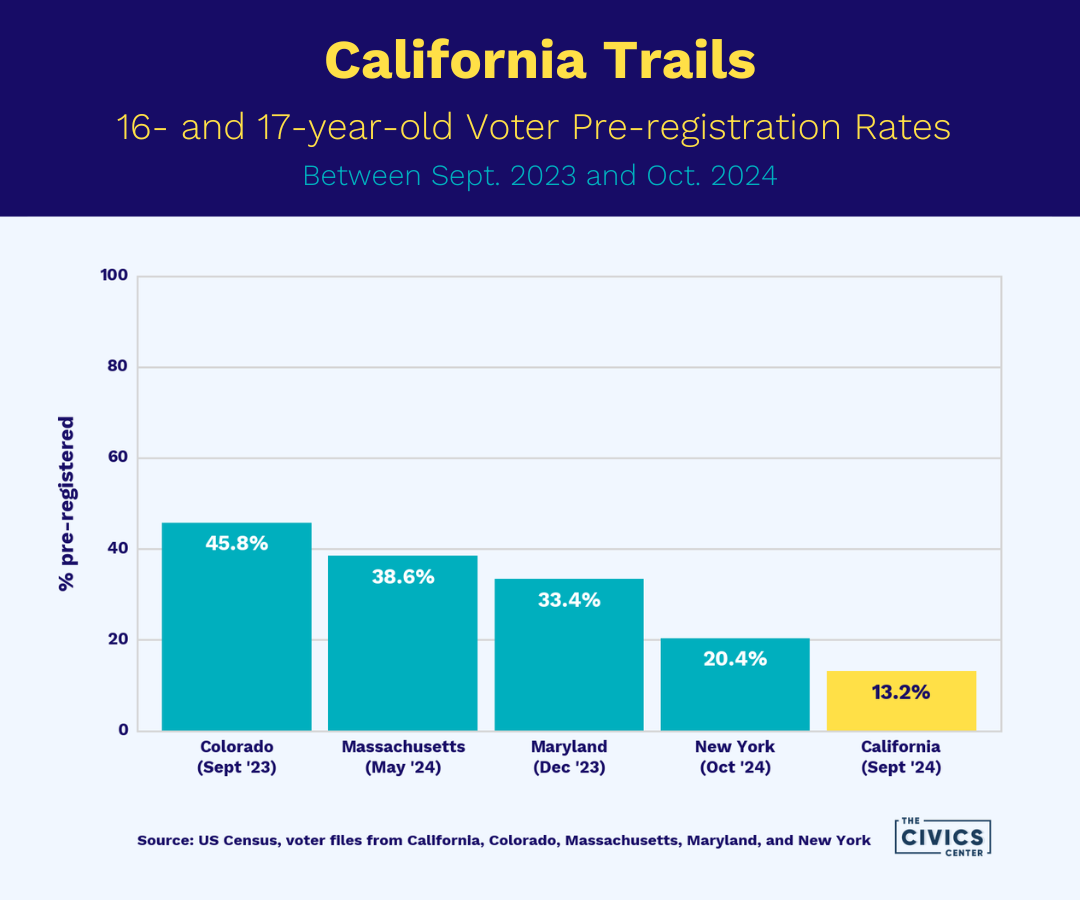Gavin Newsom *again* vetoes a measure that would have helped more young people vote
Under 15% of California’s more than 1.2 million 16- and 17-year-olds have preregistered to vote. The Governor doesn’t see the need for high schools to take up the problem.
People don’t believe me when I tell them that California Governor Newsom has repeatedly vetoed legislation passed by the California legislature that would help more young people participate in our democracy. But sadly, it’s true.
In August of this year we reported on newly released data from the Secretary of State showing that only 13% of 16- and 17-year-olds in California are registered to vote.
We repeated the message on October 16, along with a comparison of other states, showing California is last among the states we’re tracking that offer preregistration starting at age 16.
On September 27, Gavin Newsom vetoed legislation that would have fixed the problem.
You might assume “motor voter” is taking care of it, but as we reported in April 2024, California’s AVR system, adopted in 2016, was intended to be “automatic”, but that’s not how it operates. In fact, according to the state’s own analysis, it misses nearly half of the 16- and 17-year-olds who are eligible to preregister and who interact with the DMV. (To say nothing of the >50% of 16- to 19-year-old California residents who do not get a license at all.)
In Governor Newsom’s own words, Assembly Bill 2724, known as the High School Voter Registration Act would have required the governing bodies that have authority over public schools “to ensure that each of its students receives information on how to properly preregister to vote prior to the student completing grade 11.”
Many of the students we work with in California have never been taught about preregistration or the requirements to register to vote. So the simple intervention of state legislation requiring schools to provide reliable information about how to do so would have gone a long way to fixing our shockingly low rates.
And it’s not like nothing is at stake in voting in California. We have a population of 39 million. We have the largest economy in the country. If we were our own country, we’d have the fifth largest economy in the world, ranking somewhere between Germany and the UK.
California had two congressional races this year that were decided by under 1,000 votes. One was decided by under 200. For context, students we trained at Claremont High School held a drive in March that resulted in ~700 of their students registered to vote. With the state’s backing, we could quickly replicate that success in all of California’s 1300 public high schools.
But, no matter. According to Governor Newsom, “[s]chools already have the ability to fulfill the requirements of this bill without creating a new mandate.” If it’s as simple as that, why, I would ask him, were only 13% of 16- and 17-year-olds registered in September? And, according to the latest available numbers reflected in our Scorecard below, the rate inched up only slightly to 13.7% as Election Day neared. That’s just 140,535 of the more than 1.2 million 16- and 17-year-olds in the state. None of us should be satisfied.
What’s missing? Training, planning, lesson plans, outreach materials to families to ensure awareness and promote participation, and time on the calendar that is prioritized as inviolable, like other true requirements. What’s missing is the basic ingredients necessary to bring high school voter registration to life and to make it a consistent reality for students and high school communities, year after year.
So you may be wondering, why on earth did Governor Newsom veto the bill? Here’s a little insight: When he says we don’t need a “new state mandate,” what he is really saying is that he doesn’t want the state to pay for it.
Under California law, if the state enacts a state mandate that imposes burdens on local agencies, then those local agencies can demand payment from the state. That is pretty fair, because if something is a state priority enough to make it a state mandate, then it’s reasonable that the state should pay. You can read Governor Newsom’s full veto message below, so you can believe me about what’s standing in the way of improving things.
But then the question remains, if the state won’t pay to ensure universal voter registration, who will do so, and what other entity or collection of entities has the capacity to do so in a way that is equitable and that does not exacerbate economic and other inequalities that exist across the state? That is the subject of a post I wrote a few weeks ago: Who Is Responsible for Ensuring Universal Voter Registration?.
It’s a little sad when a small nonprofit like The Civics Center is taking more responsibility for high school voter registration than the mighty state of California. But for now, that’s the way it is.
Your tax dollars aren’t going to solve the problem, but your charitable 501(c)(3) contributions can.
Please consider donating to The Civics Center in support of our ongoing data and organizing work:








Thank goodness for The Civics Center. Time to expand to let non-parents help!
Laura, since this is about preregistration, and the kids can’t vote until they’re 18, is there data to correlate how low preregistration translates to low registration rates of 18 year olds, and/or turnout of eligible 18 year olds? I think that could make a compelling case if it correlates.